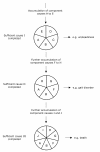Ill or just old? Towards a conceptual framework of the relation between ageing and disease
- PMID: 14683526
- PMCID: PMC317305
- DOI: 10.1186/1471-2318-3-7
Ill or just old? Towards a conceptual framework of the relation between ageing and disease
Abstract
Background: Is this person ill or just old? This question reflects the pondering mind of a doctor while interpreting the complaints of an elderly person who seeks his help. Many doctors think that ageing is a non-disease. Accordingly, various attempts have been undertaken to separate pathological ageing from normal ageing. However, the existence of a normal ageing process distinct from the pathological processes causing disease later in life can be questioned.
Discussion: Ageing is the accumulation of damage to somatic cells, leading to cellular dysfunction, and culminates in organ dysfunction and an increased vulnerability to death. Analogously, chronic diseases initiate early in life and their development is slow before they become clinically apparent and culminate in disability or death. The definition of disease is also subject to current opinions and scientific understanding and usually, it is an act of individual creativity when physical changes are recognised as symptoms of a new disease. New diseases, however, are only rarely really new. Most new diseases have gone undiagnosed because their signs and symptoms escaped recognition or were interpreted otherwise. Many physical changes in the elderly that are not yet recognised as a disease are thus ascribed to normal ageing. Therefore, the distinction between normal ageing and disease late in life seems in large part arbitrary.
Summary: We think that normal ageing cannot be separated from pathological processes causing disease later in life, and we propose that the distinction is avoided.
Figures



References
-
- Staessen JA, Gasowski J, Wang JG, Thijs L, Boissei JP, Coope J, Ekbom T, Gueyffier F, Liu L, Kerlikowske K, Pocock S, Fagard RH. Risks of untreated and treated isolated systolic hypertension in the elderly: meta-analysis of outcome trials. Lancet. 2000;355:865–872. doi: 10.1016/S0140-6736(99)07330-4. - DOI - PubMed
-
- Strehler BL. In Time, cells, and aging. New York: Academic Press; 1962. Definitions, criteria, categories, and origins of age changes; pp. 4–32.
-
- Solomon DH. The role of aging processes in aging-dependent diseases. In: Bengtson VL, Schaie KW, editor. In Handbook of theories of aging. New York: Springer Publishing Company; 1999. pp. 133–149.
-
- Finch CE. In Longevity, senescence, and the genome. Chicago: The University of Chicago Press; 1990. Introduction; pp. 3–42.
LinkOut - more resources
Full Text Sources

